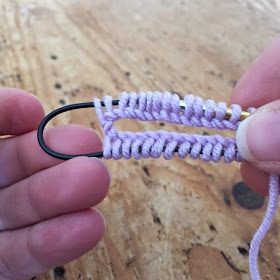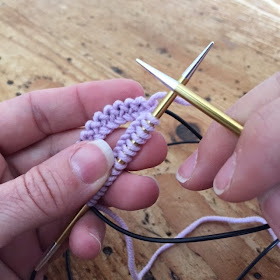 There are a couple of techniques that have revolutionised my knitting life. Regular readers will already be saying 'mattress stitch' quietly to themselves - which makes me giggle as you all know what a passionate advocate I am (to the point of obsession!) for utilising this incredible finishing technique wherever possible. But the other technique that I find myself turning to for all of my knitting in the round, is magic loop.
There are a couple of techniques that have revolutionised my knitting life. Regular readers will already be saying 'mattress stitch' quietly to themselves - which makes me giggle as you all know what a passionate advocate I am (to the point of obsession!) for utilising this incredible finishing technique wherever possible. But the other technique that I find myself turning to for all of my knitting in the round, is magic loop.I was a doggedly determined DPN user for socks and sleeves for many years until I taught myself magic loop, and since mastering it I really haven't looked back. It has so many advantages in comparison to using double points.
To begin with, many knitters find loose 'ladders' appearing between needles when using double points. It's a common enough problem and one that can be resolved by keeping a good tight tension between those joins, but is an issue that virtually disappears when using magic loop. Of course magic loop reduces the amount of gaps between needles to just 2, and for me anyway, it's easier to manage the tension between the needles as they are closer together by virtue of the way you knit from one to the other.
Another advantage is that the quantity of stitches is really only limited by the length of the cable you use. As long as you have enough spare cable on either side for manoeuvrability, then you can even knit a sweater in the round using magic loop. At the other end of the spectrum, you can go right down to just a few stitches - 4! on your needles and still manage them fairly well. At this end it becomes a little tricky but it means that you can decrease right down to the very tip of a toe or the top of a hat without having to change to clunky DPN's.
I thought it would be useful to share this technique here in the form of a picture tutorial. It's the method I used for knitting the cute Easter Egg Hats last week, and as I mentioned can be used for knitting socks, sleeves, baby clothes, mittens, toys and even adult garments in the round. Remember you can convert flat pieces to knitting in the round for something like a sleeve - you will just need to subtract the stitches allowed for seaming - usually 1 at either side.
A couple of tips for using magic loop before the tutorial:
1) Make sure your circular needle is at the least 80cms. I find this is adequate for small items, but 100cms is often more 'comfortable'. You will adjust to the length that suits you best as you become more used to magic loop.
2) Invest in a circular needle that has a nice supple cable. Some cheaper circulars have stiff, plastic cables that will hinder your progress because they are just too inflexible. The circular I am using in the tutorial is from Signature Needle Arts which was a very thoughtful gift from a friend in the US (where they are made), but I find that Addi which are available much more widely in Europe are equally good. A simple Google search will show you where you can buy them locally.
3) Don't pinch the cable too hard when you are dividing your stitches on the initial row after casting on - you don't want a kink in your cable!
1) Cast on. An even number works best for equal division of stitches.
2) Find the middle of the stitches - in this instance I cast on 32 so I found the middle after stitch number 16. Slide the stitches down so that you can pull the cable through this 'gap' between the 2 equal numbers of stitches - this is the part where you don't want to pinch that cable too hard!
3) Slide 1 set of 16 stitches up to the end of one needle and the other set of 16 stitches up onto the other so that they are lying parallel and with your working yarn coming from the stitches on the back needle.
4) It is vital here - before you begin to actually knit the first round, that you ensure your stitches are not twisted in any way. I manage this by ensuring that the edge of stitches - the nice even bottom of the stitches is facing in towards the centre and I hold them firmly between my thumb and fingers so that they don't twist as I'm knitting. Some knitters recommend that you knit the last cast on stitch with the first to try and eradicate any gap on this first round. I have found that it doesn't really make much difference and so I just start to knit without trying to avoid the gap. On the second round however, I make sure I keep the first couple of stitches quite tight and this generally removes any excess yarn between the needles on the first round. You can of course use the cast on tail to tidy it up more at the end if you need to.
5) Using the 'back' needle to knit the stitches off of the 'front' needle, continue to the end of this first needle.
6) When you have reached the end of this first needle your needle in the left hand will now be 'free'. You now need to turn your work 180 degrees so that this free needle is at the front and the needle with all the stitches you have just knitted (along with the working yarn) is at the back - effectively swapping back needle for front and front for back.
7) To begin the next needle you will need to shuffle your stitches a little. Push the front needle through from the left (and pull the cable through) so that your stitches are up onto the needle ready to be knitted. Now pull the back needle through so that the stitches you have just knitted are sitting on the cable and the needle is free ready to knit from the front set. You will always use the back needle to knit the stitches onto, and your yarn always needs to come from the back needle.
8) This picture shows progress after the very first row. You can see that there is a long strand of yarn between the needles, but as I mentioned earlier, you will be able to tighten this up in the subsequent row. As a side note, these early rows can be a little tricky to manage, but trust me - once you have knitted a few rows, it gets a whole lot easier!
9) This picture shows my knitting mid row - with the cable loops or 'bunny ears' typical of the magic loop method. There is nothing much more to the technique than that - keep on in this way, knitting the stitches off of the front needle using the back one, turning your work, pulling the cable through and starting again. If your knitting looks like this - you've conquered Magic Loop!
(posted by Max)






























